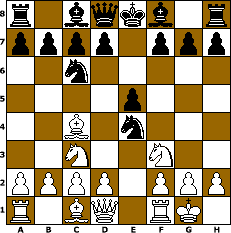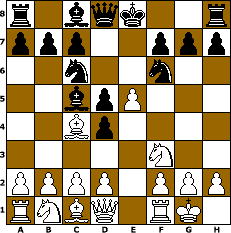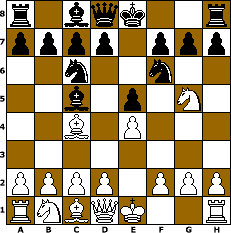The Two Knights Defense is a chess opening that begins
1. e4 e5 2. Nf3 Nc6 3. Bc4 Nf6
Analyzed by Guilio Cesare Polerio (c.1550–c.1610) in 1580, it is one of the oldest openings.
Black´s third move is a more aggressive defense than the Giuoco Piano which would result from 3...Bc5.
In fact, Bronstein suggested that the term "defense" does not fit,
and that the name "Chigorin´s Counterattack" would be more appropriate.
The Two Knights has been adopted as Black by many aggressive players including Chigorin and Keres, and World Champions Tal and Boris Spassky.
The theory of this opening has been explored extensively in correspondence chess by players such as Berliner and Estrin.
Main variations
 | | Boden-Kieseritzky Gambit |  | | Max Lange Attack |  | | Wilkes-Barre or Traxler Variation |
White must respond to the attack on his e-pawn.
4.Nc3
The attempt to defend the pawn with 4.Nc3 doesn´t work since Black can take the pawn anyway and use a fork trick to regain the piece, 4.Nc3?! Nxe4! 5.Nxe4 d5.
The try 5.Bxf7+? doesn´t help, as Black has the bishop pair and a better position after 5...Kxf7 6.Nxe4 d5.
Instead, 4.Nc3 is usually played with the intent to gambit the e-pawn with the Boden-Kieseritzky Gambit, 4.Nc3 Nxe4 5.0-0.
This gambit is not commonly seen in tournament play as it is not well regarded by opening theory, but it can offer White good practical chances especially in blitz chess.
4.d3
The quiet move 4.d3 transposes into the Giuoco Pianissimo if Black responds 4...Bc5, but there are also independent variations after 4...Be7 or 4...h6.
White tries to avoid the tactical battles that are common in other lines of the Two Knights and to enter a more positional game.
The resulting positions take on some characteristics of the Ruy Lopez if White plays c3 and retreats the bishop to c2 via Bc4-b3-c2.
This move became popular in the 1980s and has been used by John Nunn and others.
Black can confound White´s attempt to avoid tactical play with 4...d5!?.
This move is rarely played as opening theory does not approve, but Jan Pinski suggests that it is better than is commonly believed.
4.d4
White can choose to develop rapidly with 4.d4 exd4 5.0-0.
Now Black can equalize simply by eliminating White´s last center pawn with 5...Nxe4 or obtain good chances with the complex Max Lange Attack after 5...Bc5 6.e5 d5.
The extensively analyzed Max Lange can also arise from the Giuoco Piano.
White can choose to avoid these lines by playing 5.e5, a line often adopted by Sveshnikov.
After 5.e5, either 5...Ne4 or 5...Ng4 is a playable reply, but most common and natural is 5...d5 6.Bb5 Ne4 7.Nxd4 Bc5.
4.Ng5
Siegbert Tarrasch called 4.Ng5 a "duffer´s move" (ein richtiger Stümperzug) and Panov called it "primitive", but this attack on f7 practically wins a pawn by force.
Despite this criticism, many players consider 4.Ng5 to be White´s best chance for an advantage and it has been played by World Champions Steinitz, Fischer, Karpov, Kasparov, and Anand.
Czech problemist Karel Traxler played 4...Bc5!? in Reinisch–Traxler, Prague 1890.
Marshall later analyzed the variation and named it after the town Wilkes-Barre, Pennsylvania, so today 5...Bc5 is known as both the Traxler Variation and the Wilkes-Barre Variation.
This bold move ignores White´s attack on f7 and leads to wild play where some long variations have been analyzed to a draw by perpetual check.
White can play 6.d4, 6.Nxf7, or 6.Bxf7+.
Black equalizes after 6.d4 d5!.
The usual move used to be 6.Nxf7, but this is very complicated after 6...Bxf2+.
White´s best try for an advantage is probably 6.Bxf7+ Ke7 7.Bb3 or 7.Bd5.
No grandmasters regularly adopt the Wilkes-Barre as Black, but Beliavsky and Shirov have played it occasionally even in top competition.
More common is 4...d5 5.exd5.
The Black recapture 5...Nxd5?! is very risky.
Pinkus tried to bolster this move with analysis in 1943 and 1944 issues of Chess Review,
but White gets a strong attack with either the safe Lolli Variation 6.d4! or the sacrificial Fried Liver (or Fegatello) Attack 6.Nxf7!? Kxf7 7.Qf3+ Ke6 8.Nf3.
These variations are usually considered too difficult for Black to defend over the board, but they are sometimes used in correspondence play.
Instead Black usually chooses to make the opening a gambit by playing either 5...Na5 (main line), 5...Nd4 or 5...b5.
After 5...Na5, Morphy would hold on to the gambit pawn as White with 6.d3.
The Morphy Variation has not been popular, since it has long been known that Black obtains good chances for the pawn with 6...h6 7.Nf3 e5 8.Qe2 Nxc4 9.dxc4 Bc5.
Instead, White usually plays 6.Bb5+, when the play almost always continues 6...c6 7.dxc6 bxc6 8.Be2 h6.
(The move 8.Qf3?! was popular in the 19th century and is still played occasionally, but Black obtains a strong attack after either 8...h6! or 8...Rb8.)
White then has a choice of two retreat squares for the king knight.
The usual retreat is 9.Nf3 when Black obtains some initiative after 9...e4 10.Ne5 (this is considered to be the main line of the Two Knights Defense).
Steinitz favored 9.Nh3 instead although it did not bring him success in his famous 1891 cable match against Chigorin.
The Steinitz Variation was mostly forgotten until Fischer revived it in the 1960s.
Short lead a second revival of 9.Nh3 in the 1990s, and today it is thought to be about equal in strength to the more common 9.Nf3.
Black´s alternatives to 5...Na4, the Fritz Variation 5...Nd4 and Ulvestad´s Variation 5...b5, are related as they share a common main line.
American master Olav Ulvestad introduced the surprising 5...b5 in a 1941 article in Chess Review.
White has only one good reply.
Weak are 6.Bxb5 Qxd5 7.Bxc6 Qxc6 and 6.dxc6 bxc4 7.Nc3, so White should move the bishop.
The best move is actually 6.Bf1!, as this protects g2 so White can answer 6...Qxd5? with 7.Nc3.
Black´s best response is to transpose to the Fritz Variation with 6...Nd4 making another advantage of 6.Bf1 apparent—the bishop is not attacked as it would be if White had played 6.Be2.
German master Aleksander Fritz (1857–1932) suggested 5...Nd4 to Schlechter who wrote about in a 1904 issue of Deutsche Schachzeitung.
In 1907 Fritz himself wrote an article about his move in the Swedish journal Tidskrift för Schack.
White´s best reply is 6.c3, when the game often continues 6...b5 7.Bf1 Nxd5 8.Ne4 or 8.h4.
References
- Hooper, David and Kenneth Whyld (1996). The Oxford Companion To Chess. Oxford University. ISBN 0-19-280049-3.
- De Firmian, Nick (1999). Modern Chess Openings: MCO-14. Random House Puzzles & Games. ISBN 0-8129-3084-3.
- Pinski, Jan (2003). The Two Knights Defence. Everyman Chess. ISBN 1-85744-283-0.
|
